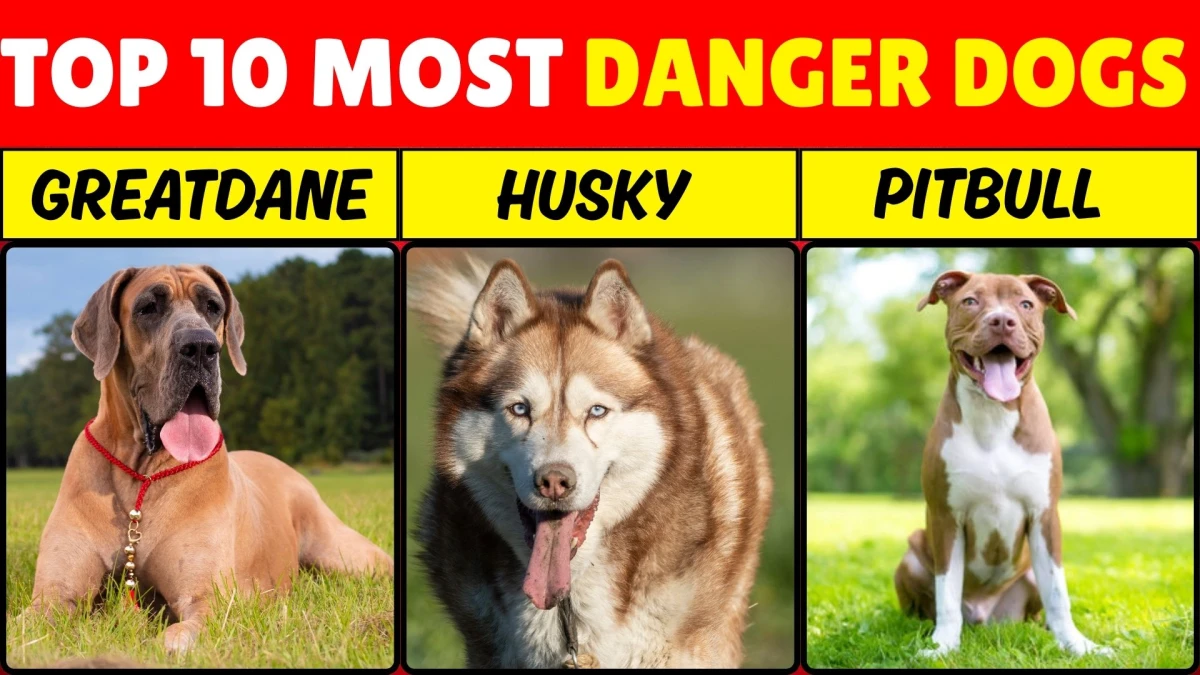Top 10 Most Dangerous Dogs in the World
When it comes to choosing a dog, breed characteristics can play a significant role in determining their temperament and behavior. While most dogs are friendly and affectionate companions, there are certain breeds that, due to their strength, guarding instincts, or aggressive tendencies, are considered more dangerous.
These breeds often require responsible ownership, proper training, and socialization to ensure they are well-behaved and safe around others.
In this list, we explore the top 10 most dangerous dogs in the world based on their history, strength, and reputation. It’s important to note that a dog’s behavior is influenced by its upbringing, environment, and the owner's ability to properly train and socialize the animal.
| Rank | Breed Name |
| 10 | Alaskan Malamutes |
| 9 | Doberman Pinscher |
| 8 | Bullmastiff |
| 7 | Boxer |
| 6 | Great dane |
| 5 | Siberian Huskies |
| 4 | German Shepherd |
| 3 | American Bulldog |
| 2 | Rottweilers |
| 1 | Pitbull |
#10. Alaskan Malamutes
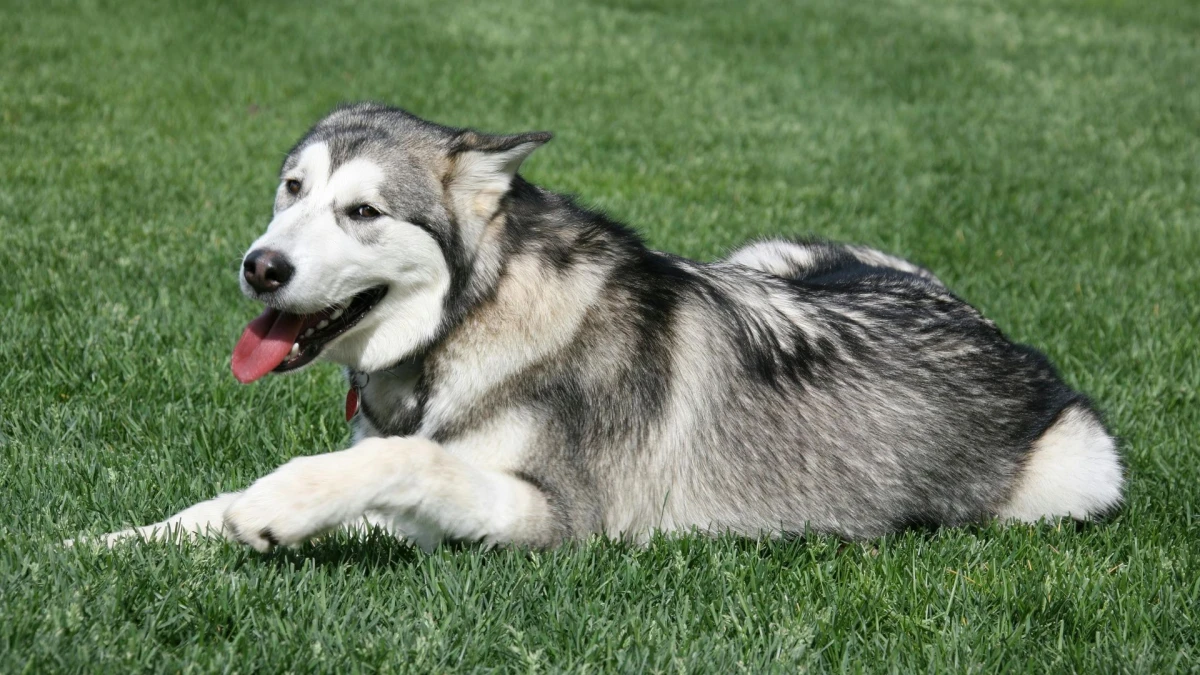
The Alaskan Malamute is a large and powerful Arctic breed of dog, originally developed for strength and endurance. Traditionally used as a sled dog, the Malamute was bred to haul heavy freight over long distances in harsh, cold environments.
Key Characteristics:
- Height: 23 to 25 inches at the shoulder
- Weight: 75 to 85 pounds
- Build: Sturdy, muscular, and built for stamina
- Coat: Thick double coat, ideal for cold climates
- Temperament: Loyal, friendly, and strong-willed
The Malamute shares many traits with similar Arctic breeds like the Siberian Husky, Greenland Dog, Samoyed, Canadian Eskimo Dog, and Spitz-type breeds.
However, compared to the Siberian Husky, the Malamute is typically larger and more robust, making it better suited for heavy pulling rather than speed.
| Origin | Alaska |
|---|---|
| Height | Males: 25 inches (64 cm) |
| Females: 23 inches (58 cm) | |
| Weight | Males: 38 kilograms (84 lb) |
| Females: 34 kilograms (75 lb) |
#9. Doberman Pinscher

The Dobermann (known as the Doberman Pinscher in the United States and Canada) is a medium-to-large German working dog breed belonging to the pinscher family. It was developed around 1890 in Thuringia, Germany, by Louis Dobermann, a tax collector who needed a protective yet obedient companion for his work.
Key Characteristics:
- Appearance: The Dobermann is known for its sleek, muscular build, long muzzle, and a graceful, athletic gait. Traditionally, its ears were cropped and its tail docked, though these practices are now illegal in many countries.
- Temperament: This breed is highly intelligent, alert, and extremely loyal. Because of its protective instincts, the Dobermann is widely used as a guard dog but is also a loving and devoted family companion when properly trained.
- Use: Commonly seen in police, military, and protection roles, it also excels in obedience, agility, and therapy work.
| Origin | Germany |
|---|---|
| Height (Males) | 68 to 72 cm (27 to 28 in) |
| Height (Females) | 63 to 68 cm (25 to 27 in) |
| Weight (Males) | 40–45 kg (90–100 lb) |
| Weight (Females) | 32–35 kg (70–75 lb) |
#8. Bullmastiff

The Bullmastiff is an English breed of dog that belongs to the mastiff type and is known for its large size, solid build, and short muzzle. This breed was developed in the 19th century as a guard dog by cross-breeding the English Mastiff with the now-extinct Old English Bulldog.
Key Characteristics:
- The Bullmastiff was specifically bred to guard estates, protecting against poachers while being less aggressive than other guard dog breeds.
- The Bullmastiff is recognized for its strength, courage, and calm temperament, making it a popular choice for those looking for a loyal and protective companion. Despite their imposing size, they are known to be gentle and affectionate with their families.
- Temperament: The Bullmastiff is known for being gentle, loyal, and protective, making it a great family companion and guard dog. Despite its imposing appearance, it is typically calm and affectionate with family members.
- Size: It is a large, powerful breed with a solid, muscular build. Males typically weigh between 50 to 59 kg (110 to 130 lbs), and females weigh between 41 to 50 kg (90 to 110 lbs).
- Coat and Color: The Bullmastiff has a short, dense coat that is typically fawn, red, or brindle in color.
- Exercise Needs: While not as energetic as some breeds, the Bullmastiff still requires regular exercise to maintain a healthy weight and muscle tone. Moderate daily walks and playtime are usually sufficient.
- Training: Due to its intelligence and strong protective instincts, the Bullmastiff is fairly easy to train, though it requires consistent leadership and socialization from an early age to ensure it is well-behaved.
| Origin | England |
|---|---|
| Height (Males) | 64–69 cm (25–27 in) |
| Height (Females) | 61–66 cm (24–26 in) |
| Weight (Males) | 50–59 kg (110–130 lb) |
| Weight (Females) | 41–50 kg (90–110 lb) |
#7. Husky

The term "Husky" generally refers to a group of sled dogs that are specifically bred for their strength, endurance, and cold-weather tolerance. These dogs are primarily used in the polar regions, especially for work as sled dogs. Huskies are known for their ability to withstand extreme cold temperatures, and they have thick double coats that help them adapt to harsh, frigid climates.
There are different types of huskies, with the Siberian Husky and the Alaskan Malamute being the most well-known. The Siberian Husky is more commonly associated with dog sledding races due to its speed and agility, whereas the Alaskan Malamute is a heavier, more powerful breed used for hauling heavy loads.
The Alaskan Husky refers to the modern racing huskies, which are crossbreeds created for speed and endurance in sled dog racing. These dogs have retained many of the traits that make them exceptional in cold climates, including thick coats, erect ears, and distinctive markings.
Key Characteristics:
- Appearance: Huskies are typically medium-sized dogs with a well-defined, athletic build. They have thick fur coats, erect triangular ears, and distinctive markings that vary by breed.
- Temperament: Known for being friendly, independent, and energetic, Huskies are great family pets but require regular exercise to stay happy and healthy.
- Endurance: Huskies are famous for their incredible stamina and endurance, making them ideal for long-distance sledding and other endurance-based activities.
- Health: Huskies are generally healthy, but they may be prone to certain health issues, including hip dysplasia and eye conditions like cataracts and progressive retinal atrophy.
- Training: Although intelligent, Huskies can be independent and stubborn, so they require firm, consistent training and socialization from an early age.
#6. Great Dane
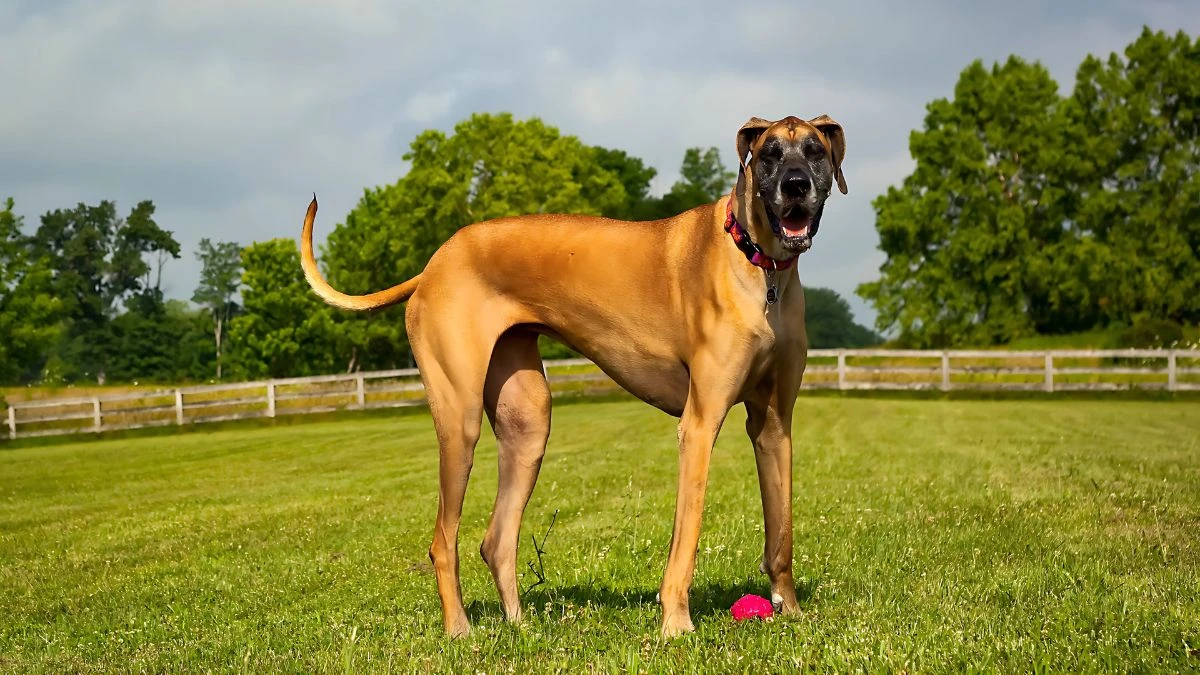
The Great Dane is a German breed known for its impressive size and strength, making it one of the two largest dog breeds in the world, alongside the Irish Wolfhound. Historically, Great Danes were used for hunting large game, such as bears, wild boar, and deer. Their role also extended to being guardians for German nobility. Over the centuries, the breed has evolved, but it still retains its majestic presence and noble lineage.
The Great Dane's ancestry dates back to the Middle Ages, where early ancestors of the breed were employed in hunting and guarding. These dogs were selectively bred from a mix of mastiffs and sighthound types, imported from England and Ireland during the sixteenth century by European nobility. In Germany, these dogs were called "Englische Docke" or "Dogge," which essentially meant "English dog." Over time, the breed’s characteristics have been refined to produce the modern Great Dane.
Key Characteristics:
- Size: The Great Dane is one of the largest dog breeds. Males typically stand between 30–34 inches (76–86 cm) at the shoulder, with some reaching over 40 inches. Weights typically range from 110 to 175 pounds (50–79 kg).
- Temperament: Despite their imposing size, Great Danes are often described as gentle giants. They are affectionate, friendly, and known for their good nature, especially around families and children. They are loyal and protective without being overly aggressive.
- Appearance: Great Danes have a sleek, muscular build and a short coat, which comes in a variety of colors, including fawn, brindle, blue, and black.
- Health: Great Danes have a relatively short lifespan, typically around 7 to 10 years, which is typical for large dog breeds. They can suffer from certain health issues, such as hip dysplasia, heart conditions like dilated cardiomyopathy, and bloat.
- Exercise Needs: Although they are large and strong, Great Danes have moderate exercise requirements compared to other large breeds. Daily walks and space to move around are essential, but they also enjoy lounging and relaxing with their families.
| Origin | Germany |
|---|---|
| Height (Males) | 80–90 cm (31–35 in) |
| Height (Females) | 72–84 cm (28–33 in) |
| Weight (Males) | 79.3 kgs (175 lbs) |
| Weight (Females) | 63.5 kgs (140 lbs) |
#5. Boxer
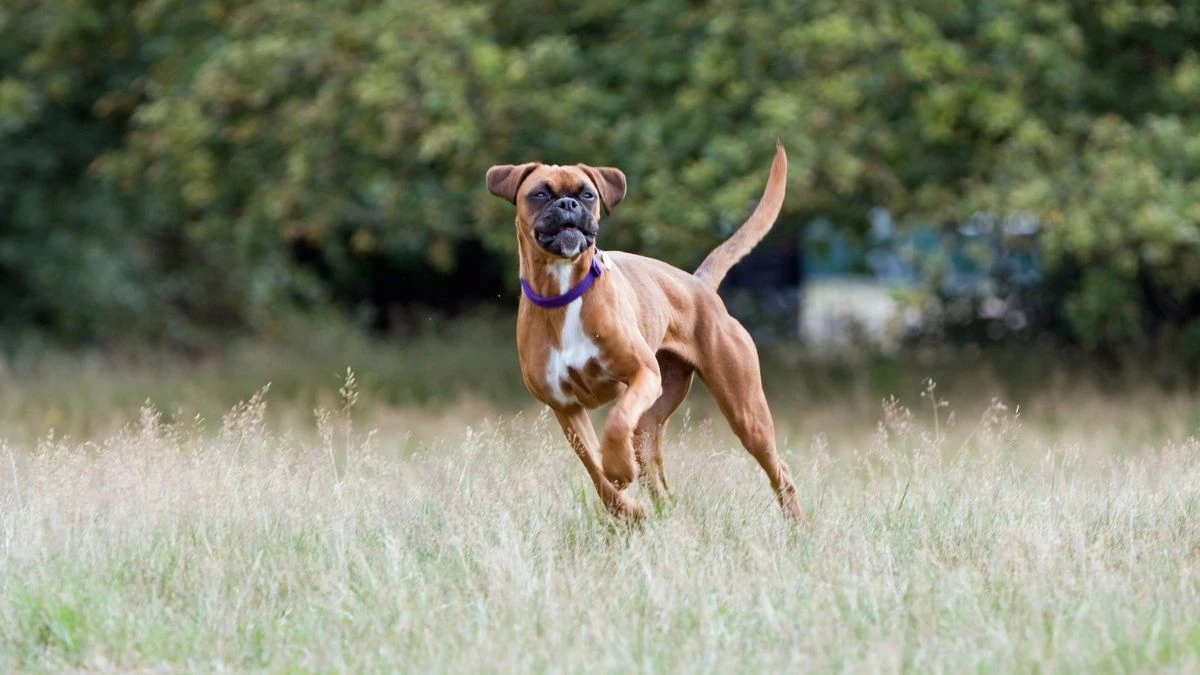
The Boxer is a medium to large, short-haired dog breed that was developed in Germany. It belongs to the mastiff-type group and is known for its distinctive features, such as a smooth, tight-fitting coat that comes in fawn or brindled colors, sometimes with white markings.
The breed is brachycephalic, meaning it has a broad, short skull, and features a square muzzle and mandibular prognathism (an underbite), giving it a strong bite ideal for holding on to large prey. Boxers have very strong jaws.
The breed was developed from the Old English Bulldog and the now-extinct Bullenbeisser, a breed that became extinct through crossbreeding rather than natural causes. The Boxer is known for being playful, energetic, and loyal, often making a great companion for families.
Key Characteristics:
- Size: Medium to large
- Coat: Short, smooth, and tight-fitting
- Color: Fawn or brindled, with or without white markings
- Head: Broad skull with a square muzzle
- Brachycephalic: Broad, short skull shape
- Teeth: Mandibular prognathism (underbite)
- Jaws: Strong and powerful bite
- Temperament: Energetic, playful, loyal, and affectionate
| Origin | Germany |
|---|---|
| Height (Males) | 56–64 cm (22–25 in) |
| Height (Females) | 53–61 cm (21–24 in) |
| Weight (Males) | 30–32 kg (66–70 lb) |
| Weight (Females) | 25–27 kg (55–60 lb) |
#4. German Shepherd
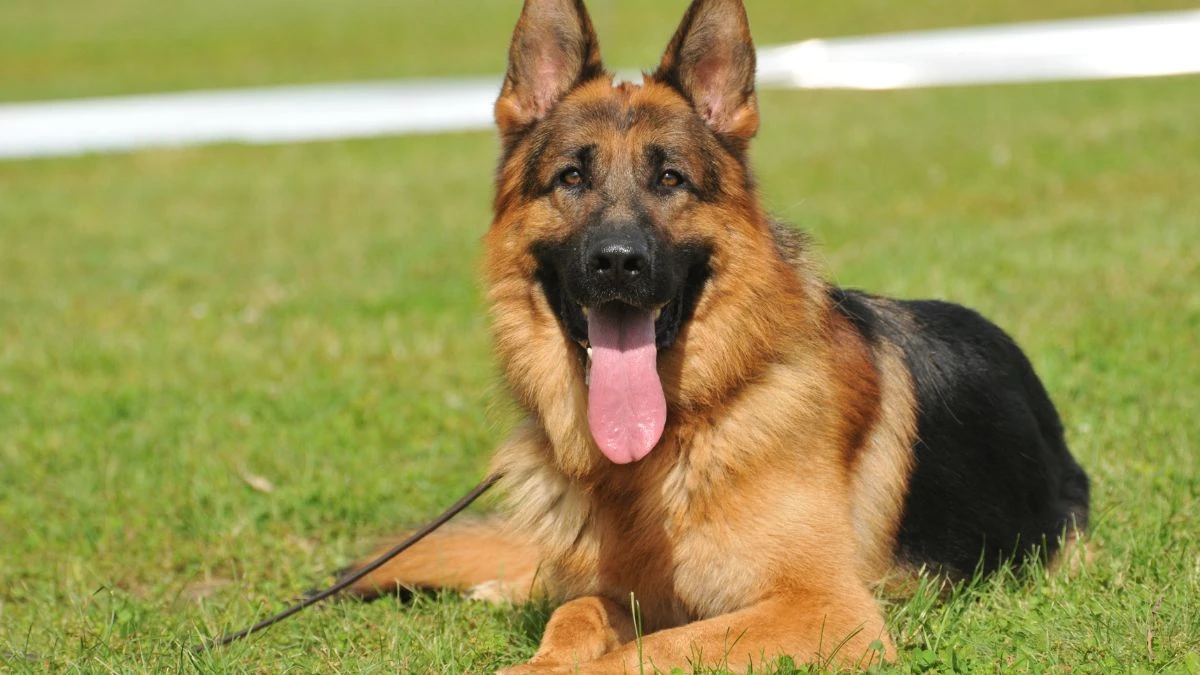
The German Shepherd, also known as the Alsatian in Britain, is a medium to large-sized breed of working dog that originated in Germany. The breed was developed in 1899 by Max von Stephanitz, who selectively bred various traditional German herding dogs to create a dog with both intelligence and versatility.
Initially bred as a herding dog for managing sheep, the German Shepherd quickly proved its worth in various other roles.
Over time, the German Shepherd became one of the most popular and reliable working dogs worldwide, excelling in numerous fields. It has been used in disability assistance, search-and-rescue, police work, and even warfare.
The breed's intelligence, loyalty, and ability to be trained for a variety of tasks made it a natural choice for these demanding roles.
The German Shepherd is also a highly adaptable breed, performing well in diverse environments and with different types of training.
Key Characteristics:
- Size: German Shepherds are medium to large-sized dogs, with males typically weighing between 65-90 pounds (29-41 kg) and females weighing between 50-70 pounds (23-32 kg).
- Coat: The breed has a dense, medium-length double coat that can be various colors, including sable, black, tan, and sometimes solid black.
- Temperament: German Shepherds are known for their intelligence, loyalty, and courage. They are protective of their family and can be reserved or aloof with strangers. They tend to form strong bonds with their owners and are highly trainable.
- Exercise Needs: This breed is highly energetic and requires daily physical and mental stimulation. Regular exercise, such as long walks, runs, and playtime, is essential to keep them happy and healthy.
| Origin | Germany |
|---|---|
| Height (Males) | 60–65 cm (24–26 in) |
| Height (Females) | 55–60 cm (22–24 in) |
| Weight (Males) | 30–40 kg (66–88 lb) |
| Weight (Females) | 22–32 kg (49–71 lb) |
#3. American Bulldog
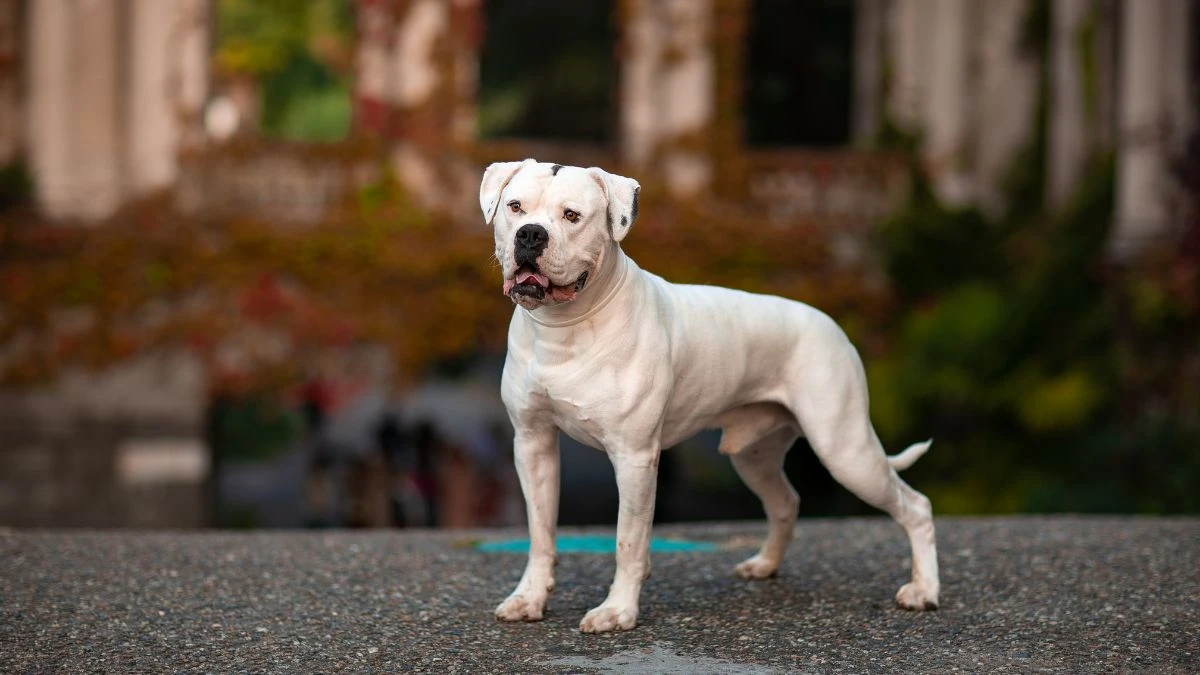
The American Bulldog is a large, muscular breed of mastiff-type dog known for its strength, agility, and protective nature. This breed traces its ancestry back to working dogs brought by British settlers to North America, where they were primarily used on small farms and ranches.
Their roles included guarding property, catching feral pigs and cattle, and providing general farm utility work.
Unlike modern standardized breeds, the American Bulldog initially developed as a landrace—a naturally occurring population shaped by the environment and functional needs rather than specific appearance.
Formal recognition and standardized breeding of dog breeds, including the American Bulldog, did not begin in the U.S. until 1884, when kennel clubs and breed registries began keeping records.
Key Characteristics
- Size: Large and powerful, males typically weigh between 75–100 pounds (34–45 kg), while females weigh 60–80 pounds (27–36 kg).
- Coat: Short, smooth, and generally low maintenance. Colors can vary but often include white with patches of brindle, black, red, or brown.
- Temperament: Loyal, brave, and affectionate with family members, but can be wary of strangers. Early socialization and training are essential.
- Exercise Needs: High. Needs daily physical activity, playtime, and mental stimulation to stay healthy and avoid boredom-related behaviors.
- Health: Prone to issues such as hip dysplasia, elbow dysplasia, and certain skin allergies. Life expectancy is generally around 10–12 years.
| Origin | United States |
|---|---|
| Height (Males) | 50–65 cm (20–26 in) |
| Height (Females) | 51–61 cm (20–24 in) |
| Weight (Males) | 34–52 kg (75–115 lb) |
| Weight (Females) | 27–41 kg (60–90 lb) |
#2. Rottweilers

The Rottweiler is a medium-to-large or large breed of domestic dog that originated in Germany. Historically known as the Rottweiler Metzgerhund, which translates to “Rottweil butchers' dog,” this breed was originally used for herding livestock and pulling carts filled with butchered meat to local markets.
This strong, hardworking heritage gave the Rottweiler its reputation for power, endurance, and intelligence.
By the mid-19th century, the rise of the railway system led to a decline in their use for herding and cart-pulling. However, the Rottweiler's natural protective instincts, intelligence, and trainability led to its adoption in roles such as police work, search and rescue, and guard duties.
Today, Rottweilers are known not only for their working abilities but also as loyal and devoted companions when properly trained and socialized.
Key Characteristics
- Coat: Short, dense, and straight. Typically black with well-defined rust or mahogany markings.
- Temperament: Loyal, confident, calm, courageous, and naturally protective.
- Trainability: Very high, but requires a firm and consistent handler.
- Exercise Needs: High – requires daily physical activity and mental stimulation.
- Lifespan: Around 8–10 years.
- Common Uses: Guard dog, police dog, service dog, companion, and search & rescue dog.
| Origin | Germany |
|---|---|
| Height (Males) | 61–69 cm (24–27 in) |
| Height (Females) | 56–63 cm (22–25 in) |
| Weight (Males) | 50–60 kg (110–132 lb) |
| Weight (Females) | 35–48 kg (77–106 lb) |
#1.Pitbull

Pit bull" is a broad term used to describe several dog breeds that originated from crosses between bulldogs and terriers. In the United States, it typically refers to breeds such as the American Pit Bull Terrier, American Staffordshire Terrier, American Bully, Staffordshire Bull Terrier, and sometimes the American Bulldog, as well as mixed-breed dogs with similar physical traits.
In contrast, countries like the United Kingdom use the term specifically for the American Pit Bull Terrier, and do not generally classify the Staffordshire Bull Terrier as a pit bull.
Key Characteristics
- Temperament: Loyal, Confident, Energetic, Protective
- Size: Medium
- Weight: 30–85 lbs (13–38 kg) depending on the breed
- Height: 17–21 inches (43–53 cm)
- Lifespan: 12–16 years
- Coat: Short, smooth, and glossy
- Colors: Variety including black, brindle, fawn, blue, red, white, or a mix
- Exercise Needs: High – requires daily activity
- Trainability: Intelligent and eager to please, responds well to positive reinforcement
| Origin | United States, Great Britain |
|---|---|
| Height (Males) | 61–69 cm (24–27 in) |
| Height (Females) | 56–63 cm (22–25 in) |
| Weight (Males) | 50–60 kg (110–132 lb) |
| Weight (Females) | 35–48 kg (77–106 lb) |

